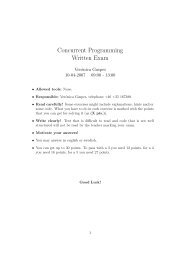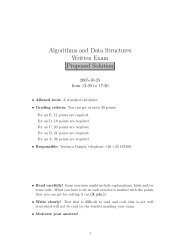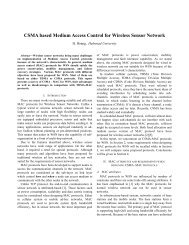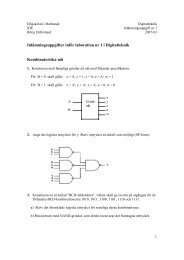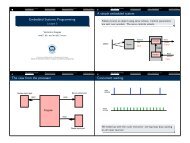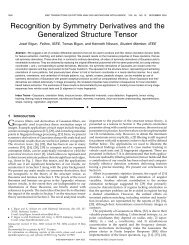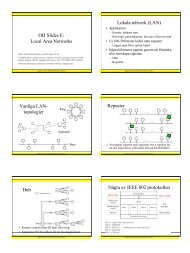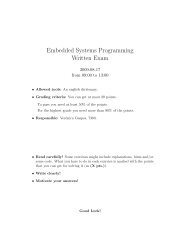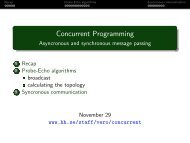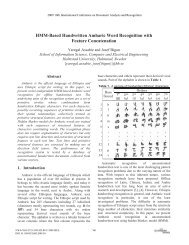presentation
presentation
presentation
Create successful ePaper yourself
Turn your PDF publications into a flip-book with our unique Google optimized e-Paper software.
Busy waiting vs Interrupts<br />
The reactive embedded system<br />
Embedded Systems Programming<br />
Lecture 5<br />
Verónica Gaspes<br />
www2.hh.se/staff/vero<br />
Center for Research on Embedded Systems<br />
School of Information Science, Computer and Electrical Engineering
Busy waiting vs Interrupts<br />
The reactive embedded system<br />
What we have learned . . .<br />
We know how to read and write to I/O device registers<br />
We know how to run several computations in parallel by<br />
time-slicing the CPU<br />
We know how to protect critical sections by means of a mutex<br />
But . . .
Busy waiting vs Interrupts<br />
The reactive embedded system<br />
What we have learned . . .<br />
We know how to read and write to I/O device registers<br />
We know how to run several computations in parallel by<br />
time-slicing the CPU<br />
We know how to protect critical sections by means of a mutex<br />
But . . .
Busy waiting vs Interrupts<br />
The reactive embedded system<br />
What we have learned . . .<br />
We know how to read and write to I/O device registers<br />
We know how to run several computations in parallel by<br />
time-slicing the CPU<br />
We know how to protect critical sections by means of a mutex<br />
But . . .
Busy waiting vs Interrupts<br />
The reactive embedded system<br />
What we have learned . . .<br />
We know how to read and write to I/O device registers<br />
We know how to run several computations in parallel by<br />
time-slicing the CPU<br />
We know how to protect critical sections by means of a mutex<br />
But . . .
Busy waiting vs Interrupts<br />
The reactive embedded system<br />
What we have learned . . .<br />
We know how to read and write to I/O device registers<br />
We know how to run several computations in parallel by<br />
time-slicing the CPU<br />
We know how to protect critical sections by means of a mutex<br />
But . . .
Busy waiting vs Interrupts<br />
The reactive embedded system<br />
Still not satisfied!<br />
void controller_main() {<br />
int dist, signal;<br />
while(1){<br />
dist = sonar_read();<br />
}<br />
}<br />
control(dist,<br />
&signal,<br />
¶ms);<br />
servo_write(signal);<br />
void decoder_main() {<br />
struct Packet packet;<br />
while(1){<br />
radio_read(&packet);<br />
}<br />
}<br />
decode(&packet,¶ms);<br />
←− Time slicing −→<br />
Each thread gets half of the CPU cycles, irrespective of whether it<br />
is waiting or computing !
Busy waiting vs Interrupts<br />
The reactive embedded system<br />
Still not satisfied!<br />
void controller_main() {<br />
int dist, signal;<br />
while(1){<br />
dist = sonar_read();<br />
}<br />
}<br />
control(dist,<br />
&signal,<br />
¶ms);<br />
servo_write(signal);<br />
void decoder_main() {<br />
struct Packet packet;<br />
while(1){<br />
radio_read(&packet);<br />
}<br />
}<br />
decode(&packet,¶ms);<br />
←− Time slicing −→<br />
Each thread gets half of the CPU cycles, irrespective of whether it<br />
is waiting or computing !
Busy waiting vs Interrupts<br />
The reactive embedded system<br />
Consequence 1<br />
B B B<br />
A A A<br />
t(ms)<br />
Say each thread gets Tms for execution, both waiting and<br />
computing!
Busy waiting vs Interrupts<br />
The reactive embedded system<br />
Consequence 1<br />
B<br />
B<br />
B<br />
A<br />
A<br />
A<br />
t(ms)<br />
Say that an event that A is waiting for occurs now . . .
Busy waiting vs Interrupts<br />
The reactive embedded system<br />
Consequence 1<br />
B<br />
B<br />
B<br />
A<br />
A<br />
A<br />
t(ms)<br />
. . . it will not be noticed until now!
Busy waiting vs Interrupts<br />
The reactive embedded system<br />
Consequence 1<br />
With N threads in the system, each getting Tms for execution, a<br />
status change might have to wait up to T*(N-1)ms to be noticed!
Busy waiting vs Interrupts<br />
The reactive embedded system<br />
Consequence 2<br />
Average time between input events<br />
Compute<br />
Busy Wait<br />
Thread A<br />
Thread B<br />
A<br />
B<br />
A<br />
B<br />
A<br />
B<br />
A<br />
B<br />
A<br />
B<br />
A<br />
B<br />
A<br />
B<br />
A<br />
B<br />
A<br />
B<br />
A<br />
Average time between input events<br />
Busy waiting makes waiting indistinguishable from computing.<br />
Thread A cannot keep up with event rate!
Busy waiting vs Interrupts<br />
The reactive embedded system<br />
Busy waiting and Time slicing<br />
Minus . . .<br />
1 Not a satisfactory technique for input synchronization if the<br />
system must meet real-time constraints!<br />
2 Not a satisfactory technique for a system that is battery<br />
driven: 100% CPU cycle usage (100% power usage!).<br />
Could we do otherwise?<br />
An input synchronization technique that does not require the<br />
receiver of data to actively ask whether data has arrived.
Busy waiting vs Interrupts<br />
The reactive embedded system<br />
Busy waiting and Time slicing<br />
Minus . . .<br />
1 Not a satisfactory technique for input synchronization if the<br />
system must meet real-time constraints!<br />
2 Not a satisfactory technique for a system that is battery<br />
driven: 100% CPU cycle usage (100% power usage!).<br />
Could we do otherwise?<br />
An input synchronization technique that does not require the<br />
receiver of data to actively ask whether data has arrived.
Busy waiting vs Interrupts<br />
The reactive embedded system<br />
Busy waiting and Time slicing<br />
Minus . . .<br />
1 Not a satisfactory technique for input synchronization if the<br />
system must meet real-time constraints!<br />
2 Not a satisfactory technique for a system that is battery<br />
driven: 100% CPU cycle usage (100% power usage!).<br />
Could we do otherwise?<br />
An input synchronization technique that does not require the<br />
receiver of data to actively ask whether data has arrived.
Busy waiting vs Interrupts<br />
The reactive embedded system<br />
Busy waiting and Time slicing<br />
Minus . . .<br />
1 Not a satisfactory technique for input synchronization if the<br />
system must meet real-time constraints!<br />
2 Not a satisfactory technique for a system that is battery<br />
driven: 100% CPU cycle usage (100% power usage!).<br />
Could we do otherwise?<br />
An input synchronization technique that does not require the<br />
receiver of data to actively ask whether data has arrived.
Busy waiting vs Interrupts<br />
The reactive embedded system<br />
The naked computer – a mismatch<br />
CPU<br />
read<br />
write<br />
read<br />
write<br />
Port<br />
RAM<br />
Port
Busy waiting vs Interrupts<br />
The reactive embedded system<br />
The naked computer – alternative<br />
CPU<br />
Port initiated "write"<br />
write<br />
read<br />
write<br />
Port<br />
RAM<br />
Port
Busy waiting vs Interrupts<br />
The reactive embedded system<br />
An analogy<br />
You are expecting delivery of your latest web-shop purchase<br />
Busy waiting<br />
Go to the post-office again and<br />
again to check if the delivery has<br />
arrived.<br />
Reacting to an interrupt<br />
Receive a note in your mailbox<br />
that the goods can be picked up.<br />
The CPU reacts to an interrupt signal by executing a designated<br />
ISR (interrupt service routine)<br />
This has consequences for the way we structure programs. They<br />
become inside-out!
Busy waiting vs Interrupts<br />
The reactive embedded system<br />
An analogy<br />
You are expecting delivery of your latest web-shop purchase<br />
Busy waiting<br />
Go to the post-office again and<br />
again to check if the delivery has<br />
arrived.<br />
Reacting to an interrupt<br />
Receive a note in your mailbox<br />
that the goods can be picked up.<br />
The CPU reacts to an interrupt signal by executing a designated<br />
ISR (interrupt service routine)<br />
This has consequences for the way we structure programs. They<br />
become inside-out!
Busy waiting vs Interrupts<br />
The reactive embedded system<br />
An analogy<br />
You are expecting delivery of your latest web-shop purchase<br />
Busy waiting<br />
Go to the post-office again and<br />
again to check if the delivery has<br />
arrived.<br />
Reacting to an interrupt<br />
Receive a note in your mailbox<br />
that the goods can be picked up.<br />
The CPU reacts to an interrupt signal by executing a designated<br />
ISR (interrupt service routine)<br />
This has consequences for the way we structure programs. They<br />
become inside-out!
Busy waiting vs Interrupts<br />
The reactive embedded system<br />
An analogy<br />
You are expecting delivery of your latest web-shop purchase<br />
Busy waiting<br />
Go to the post-office again and<br />
again to check if the delivery has<br />
arrived.<br />
Reacting to an interrupt<br />
Receive a note in your mailbox<br />
that the goods can be picked up.<br />
The CPU reacts to an interrupt signal by executing a designated<br />
ISR (interrupt service routine)<br />
This has consequences for the way we structure programs. They<br />
become inside-out!
Busy waiting vs Interrupts<br />
The reactive embedded system<br />
An analogy<br />
You are expecting delivery of your latest web-shop purchase<br />
Busy waiting<br />
Go to the post-office again and<br />
again to check if the delivery has<br />
arrived.<br />
Reacting to an interrupt<br />
Receive a note in your mailbox<br />
that the goods can be picked up.<br />
The CPU reacts to an interrupt signal by executing a designated<br />
ISR (interrupt service routine)<br />
This has consequences for the way we structure programs. They<br />
become inside-out!
Busy waiting vs Interrupts<br />
The reactive embedded system<br />
ISRs vs functions<br />
Busy waiting<br />
We defined functions like<br />
sonar read that can be called in<br />
the program. The CPU decides<br />
when to call the function:<br />
while(1){<br />
sonar_read();<br />
control();<br />
}<br />
Reacting<br />
We define ISRs. These are not<br />
called from the program, but the<br />
code is executed when an<br />
interrupt occurs:<br />
ISR(SIG_SONAR){<br />
control();<br />
}<br />
Input detection = the exit from<br />
the busy waiting fragment (a<br />
function return)<br />
Input detection = invocation of<br />
the ISR (as if the hardware did a<br />
function call)
Busy waiting vs Interrupts<br />
The reactive embedded system<br />
ISRs vs functions<br />
Busy waiting<br />
We defined functions like<br />
sonar read that can be called in<br />
the program. The CPU decides<br />
when to call the function:<br />
while(1){<br />
sonar_read();<br />
control();<br />
}<br />
Reacting<br />
We define ISRs. These are not<br />
called from the program, but the<br />
code is executed when an<br />
interrupt occurs:<br />
ISR(SIG_SONAR){<br />
control();<br />
}<br />
Input detection = the exit from<br />
the busy waiting fragment (a<br />
function return)<br />
Input detection = invocation of<br />
the ISR (as if the hardware did a<br />
function call)
Busy waiting vs Interrupts<br />
The reactive embedded system<br />
ISRs vs functions<br />
Busy waiting<br />
We defined functions like<br />
sonar read that can be called in<br />
the program. The CPU decides<br />
when to call the function:<br />
while(1){<br />
sonar_read();<br />
control();<br />
}<br />
Reacting<br />
We define ISRs. These are not<br />
called from the program, but the<br />
code is executed when an<br />
interrupt occurs:<br />
ISR(SIG_SONAR){<br />
control();<br />
}<br />
Input detection = the exit from<br />
the busy waiting fragment (a<br />
function return)<br />
Input detection = invocation of<br />
the ISR (as if the hardware did a<br />
function call)
Busy waiting vs Interrupts<br />
The reactive embedded system<br />
ISRs vs functions<br />
Busy waiting<br />
We defined functions like<br />
sonar read that can be called in<br />
the program. The CPU decides<br />
when to call the function:<br />
while(1){<br />
sonar_read();<br />
control();<br />
}<br />
Reacting<br />
We define ISRs. These are not<br />
called from the program, but the<br />
code is executed when an<br />
interrupt occurs:<br />
ISR(SIG_SONAR){<br />
control();<br />
}<br />
Input detection = the exit from<br />
the busy waiting fragment (a<br />
function return)<br />
Input detection = invocation of<br />
the ISR (as if the hardware did a<br />
function call)
Busy waiting vs Interrupts<br />
The reactive embedded system<br />
ISRs vs functions<br />
Busy waiting<br />
We defined functions like<br />
sonar read that can be called in<br />
the program. The CPU decides<br />
when to call the function:<br />
while(1){<br />
sonar_read();<br />
control();<br />
}<br />
Reacting<br />
We define ISRs. These are not<br />
called from the program, but the<br />
code is executed when an<br />
interrupt occurs:<br />
ISR(SIG_SONAR){<br />
control();<br />
}<br />
Input detection = the exit from<br />
the busy waiting fragment (a<br />
function return)<br />
Input detection = invocation of<br />
the ISR (as if the hardware did a<br />
function call)
Busy waiting vs Interrupts<br />
The reactive embedded system<br />
Two ways of organizing programs<br />
CPU centric<br />
One thread of control that runs<br />
from start to stop (or forever)<br />
reading and writing data as it<br />
goes.<br />
Reacting CPU<br />
A set of code fragments that<br />
constitute the reactions to<br />
recognized events.<br />
The main part of the course from now on will focus on the reactive<br />
view.
Busy waiting vs Interrupts<br />
The reactive embedded system<br />
Two ways of organizing programs<br />
CPU centric<br />
One thread of control that runs<br />
from start to stop (or forever)<br />
reading and writing data as it<br />
goes.<br />
Reacting CPU<br />
A set of code fragments that<br />
constitute the reactions to<br />
recognized events.<br />
The main part of the course from now on will focus on the reactive<br />
view.
Busy waiting vs Interrupts<br />
The reactive embedded system<br />
Two ways of organizing programs<br />
CPU centric<br />
One thread of control that runs<br />
from start to stop (or forever)<br />
reading and writing data as it<br />
goes.<br />
Reacting CPU<br />
A set of code fragments that<br />
constitute the reactions to<br />
recognized events.<br />
The main part of the course from now on will focus on the reactive<br />
view.
Busy waiting vs Interrupts<br />
The reactive embedded system<br />
Two ways of organizing programs<br />
CPU centric<br />
One thread of control that runs<br />
from start to stop (or forever)<br />
reading and writing data as it<br />
goes.<br />
Reacting CPU<br />
A set of code fragments that<br />
constitute the reactions to<br />
recognized events.<br />
The main part of the course from now on will focus on the reactive<br />
view.
Busy waiting vs Interrupts<br />
The reactive embedded system<br />
The reactive embedded system<br />
Application<br />
Sensor<br />
Sensor<br />
Port<br />
Port<br />
Sensor A<br />
Sensor B<br />
Port<br />
Actuator
Busy waiting vs Interrupts<br />
The reactive embedded system<br />
The reactive embedded system<br />
Application<br />
driver<br />
Sensor<br />
Sensor<br />
Port<br />
Port<br />
Sensor A<br />
Sensor B<br />
driver<br />
app<br />
Port<br />
Actuator
Busy waiting vs Interrupts<br />
The reactive embedded system<br />
Reactive Objects<br />
Boxes<br />
Represent software or hardware reactive objects that:<br />
Maintain an internal state (variables, registers, etc)<br />
Provide a set of methods as reactions to external events<br />
(ISRs, etc)<br />
Simply rest between reactions!<br />
Arrows<br />
Represent event or signal or message flow between objects that can<br />
be either<br />
asynchronous<br />
synchronous
Busy waiting vs Interrupts<br />
The reactive embedded system<br />
Reactive Objects<br />
Boxes<br />
Represent software or hardware reactive objects that:<br />
Maintain an internal state (variables, registers, etc)<br />
Provide a set of methods as reactions to external events<br />
(ISRs, etc)<br />
Simply rest between reactions!<br />
Arrows<br />
Represent event or signal or message flow between objects that can<br />
be either<br />
asynchronous<br />
synchronous
Busy waiting vs Interrupts<br />
The reactive embedded system<br />
Reactive Objects<br />
Boxes<br />
Represent software or hardware reactive objects that:<br />
Maintain an internal state (variables, registers, etc)<br />
Provide a set of methods as reactions to external events<br />
(ISRs, etc)<br />
Simply rest between reactions!<br />
Arrows<br />
Represent event or signal or message flow between objects that can<br />
be either<br />
asynchronous<br />
synchronous
Busy waiting vs Interrupts<br />
The reactive embedded system<br />
Reactive Objects<br />
Boxes<br />
Represent software or hardware reactive objects that:<br />
Maintain an internal state (variables, registers, etc)<br />
Provide a set of methods as reactions to external events<br />
(ISRs, etc)<br />
Simply rest between reactions!<br />
Arrows<br />
Represent event or signal or message flow between objects that can<br />
be either<br />
asynchronous<br />
synchronous
Busy waiting vs Interrupts<br />
The reactive embedded system<br />
Hardware objects<br />
Hardware devices are reactive objects<br />
A black box that does nothing unless stimulated by external events.<br />
Serial port - state<br />
Internal registers<br />
Serial port - stimuli<br />
Signal change<br />
Bit pattern received<br />
Clock pulse<br />
Serial port - emissions<br />
Signal change<br />
Interrupt signal
Busy waiting vs Interrupts<br />
The reactive embedded system<br />
Hardware objects<br />
Hardware devices are reactive objects<br />
A black box that does nothing unless stimulated by external events.<br />
Serial port - state<br />
Internal registers<br />
Serial port - stimuli<br />
Signal change<br />
Bit pattern received<br />
Clock pulse<br />
Serial port - emissions<br />
Signal change<br />
Interrupt signal
Busy waiting vs Interrupts<br />
The reactive embedded system<br />
Hardware objects<br />
Hardware devices are reactive objects<br />
A black box that does nothing unless stimulated by external events.<br />
Serial port - state<br />
Internal registers<br />
Serial port - stimuli<br />
Signal change<br />
Bit pattern received<br />
Clock pulse<br />
Serial port - emissions<br />
Signal change<br />
Interrupt signal
Busy waiting vs Interrupts<br />
The reactive embedded system<br />
Hardware objects<br />
Hardware devices are reactive objects<br />
A black box that does nothing unless stimulated by external events.<br />
Serial port - state<br />
Internal registers<br />
Serial port - stimuli<br />
Signal change<br />
Bit pattern received<br />
Clock pulse<br />
Serial port - emissions<br />
Signal change<br />
Interrupt signal
Busy waiting vs Interrupts<br />
The reactive embedded system<br />
Software objects<br />
We would like to regard software objects as reactive objects . . .<br />
The Counter example<br />
class Counter{<br />
int x;<br />
Counter(){x=0;}<br />
void inc(){x++;}<br />
int read(){return x;}<br />
void reset(){x=0;}<br />
void show(){<br />
System.out.print(x);}<br />
}<br />
Counter state<br />
x<br />
Counter - stimuli<br />
inc(), read(),<br />
reset(), show()<br />
Counter - emissions<br />
print() to the object<br />
System.out
Busy waiting vs Interrupts<br />
The reactive embedded system<br />
Software objects<br />
We would like to regard software objects as reactive objects . . .<br />
The Counter example<br />
class Counter{<br />
int x;<br />
Counter(){x=0;}<br />
void inc(){x++;}<br />
int read(){return x;}<br />
void reset(){x=0;}<br />
void show(){<br />
System.out.print(x);}<br />
}<br />
Counter state<br />
x<br />
Counter - stimuli<br />
inc(), read(),<br />
reset(), show()<br />
Counter - emissions<br />
print() to the object<br />
System.out
Busy waiting vs Interrupts<br />
The reactive embedded system<br />
Software objects<br />
We would like to regard software objects as reactive objects . . .<br />
The Counter example<br />
class Counter{<br />
int x;<br />
Counter(){x=0;}<br />
void inc(){x++;}<br />
int read(){return x;}<br />
void reset(){x=0;}<br />
void show(){<br />
System.out.print(x);}<br />
}<br />
Counter state<br />
x<br />
Counter - stimuli<br />
inc(), read(),<br />
reset(), show()<br />
Counter - emissions<br />
print() to the object<br />
System.out
Busy waiting vs Interrupts<br />
The reactive embedded system<br />
Software objects<br />
We would like to regard software objects as reactive objects . . .<br />
The Counter example<br />
class Counter{<br />
int x;<br />
Counter(){x=0;}<br />
void inc(){x++;}<br />
int read(){return x;}<br />
void reset(){x=0;}<br />
void show(){<br />
System.out.print(x);}<br />
}<br />
Counter state<br />
x<br />
Counter - stimuli<br />
inc(), read(),<br />
reset(), show()<br />
Counter - emissions<br />
print() to the object<br />
System.out
Busy waiting vs Interrupts<br />
The reactive embedded system<br />
Software objects<br />
We would like to regard software objects as reactive objects . . .<br />
The Counter example<br />
class Counter{<br />
int x;<br />
Counter(){x=0;}<br />
void inc(){x++;}<br />
int read(){return x;}<br />
void reset(){x=0;}<br />
void show(){<br />
System.out.print(x);}<br />
}<br />
Counter state<br />
x<br />
Counter - stimuli<br />
inc(), read(),<br />
reset(), show()<br />
Counter - emissions<br />
print() to the object<br />
System.out
Busy waiting vs Interrupts<br />
The reactive embedded system<br />
Back to our running example<br />
Object<br />
Sonar<br />
Distance<br />
data<br />
Input<br />
Controller<br />
Control<br />
Params<br />
Servo<br />
signals<br />
Output<br />
Decoder<br />
Radio<br />
packets<br />
Input<br />
All messages/events are asynchronous! Either generated by the<br />
CPU or by the sonar hw or by the communication hardware.
Busy waiting vs Interrupts<br />
The reactive embedded system<br />
Reactive Objects<br />
Object Oriented Programming?<br />
Objects have local state<br />
Objects export methods<br />
Objects communicate by sending messages<br />
Objects rest between method invocation<br />
Examples of intuitive objects<br />
People, cars, molechules, . . .<br />
Bonus<br />
Principles and methodologies from OOP become applicable to<br />
embedded, event-driven and concurrent systems!
Busy waiting vs Interrupts<br />
The reactive embedded system<br />
Reactive Objects<br />
Object Oriented Programming?<br />
Objects have local state<br />
Objects export methods<br />
Objects communicate by sending messages<br />
Objects rest between method invocation<br />
Examples of intuitive objects<br />
People, cars, molechules, . . .<br />
Bonus<br />
Principles and methodologies from OOP become applicable to<br />
embedded, event-driven and concurrent systems!
Busy waiting vs Interrupts<br />
The reactive embedded system<br />
Reactive Objects<br />
Object Oriented Programming?<br />
Objects have local state<br />
Objects export methods<br />
Objects communicate by sending messages<br />
Objects rest between method invocation<br />
Examples of intuitive objects<br />
People, cars, molechules, . . .<br />
Bonus<br />
Principles and methodologies from OOP become applicable to<br />
embedded, event-driven and concurrent systems!
Busy waiting vs Interrupts<br />
The reactive embedded system<br />
Reactive Objects<br />
Object Oriented Programming?<br />
Objects have local state<br />
Objects export methods<br />
Objects communicate by sending messages<br />
Objects rest between method invocation<br />
Examples of intuitive objects<br />
People, cars, molechules, . . .<br />
Bonus<br />
Principles and methodologies from OOP become applicable to<br />
embedded, event-driven and concurrent systems!
Busy waiting vs Interrupts<br />
The reactive embedded system<br />
Reactive Objects<br />
Object Oriented Programming?<br />
Objects have local state<br />
Objects export methods<br />
Objects communicate by sending messages<br />
Objects rest between method invocation<br />
Examples of intuitive objects<br />
People, cars, molechules, . . .<br />
Bonus<br />
Principles and methodologies from OOP become applicable to<br />
embedded, event-driven and concurrent systems!
Busy waiting vs Interrupts<br />
The reactive embedded system<br />
Reactive Objects<br />
Object Oriented Programming?<br />
Objects have local state<br />
Objects export methods<br />
Objects communicate by sending messages<br />
Objects rest between method invocation<br />
Examples of intuitive objects<br />
People, cars, molechules, . . .<br />
Bonus<br />
Principles and methodologies from OOP become applicable to<br />
embedded, event-driven and concurrent systems!
Busy waiting vs Interrupts<br />
The reactive embedded system<br />
Reactive Objects<br />
Object Oriented Programming?<br />
Objects have local state<br />
Objects export methods<br />
Objects communicate by sending messages<br />
Objects rest between method invocation<br />
Examples of intuitive objects<br />
People, cars, molechules, . . .<br />
Bonus<br />
Principles and methodologies from OOP become applicable to<br />
embedded, event-driven and concurrent systems!
Busy waiting vs Interrupts<br />
The reactive embedded system<br />
Java? C++?<br />
The Counter example again<br />
class Counter{<br />
int x;<br />
Counter(){x=0;}<br />
void inc(){x++;}<br />
int read(){return x;}<br />
void reset(){x=0;}<br />
}<br />
One thread<br />
public static void main(){<br />
Counter c = new Counter();<br />
c.inc();<br />
System.out.println(c.read());<br />
}<br />
Creating a new object just creates a passive piece of storage! Not<br />
a thread of control!<br />
Other threads that use the same counter are sharing the state!<br />
Counting visitors to a park
Busy waiting vs Interrupts<br />
The reactive embedded system<br />
Java? C++?<br />
The Counter example again<br />
class Counter{<br />
int x;<br />
Counter(){x=0;}<br />
void inc(){x++;}<br />
int read(){return x;}<br />
void reset(){x=0;}<br />
}<br />
One thread<br />
public static void main(){<br />
Counter c = new Counter();<br />
c.inc();<br />
System.out.println(c.read());<br />
}<br />
Creating a new object just creates a passive piece of storage! Not<br />
a thread of control!<br />
Other threads that use the same counter are sharing the state!<br />
Counting visitors to a park
Busy waiting vs Interrupts<br />
The reactive embedded system<br />
Java? C++?<br />
The Counter example again<br />
class Counter{<br />
int x;<br />
Counter(){x=0;}<br />
void inc(){x++;}<br />
int read(){return x;}<br />
void reset(){x=0;}<br />
}<br />
One thread<br />
public static void main(){<br />
Counter c = new Counter();<br />
c.inc();<br />
System.out.println(c.read());<br />
}<br />
Creating a new object just creates a passive piece of storage! Not<br />
a thread of control!<br />
Other threads that use the same counter are sharing the state!<br />
Counting visitors to a park
Busy waiting vs Interrupts<br />
The reactive embedded system<br />
Java? C++?<br />
The Counter example again<br />
class Counter{<br />
int x;<br />
Counter(){x=0;}<br />
void inc(){x++;}<br />
int read(){return x;}<br />
void reset(){x=0;}<br />
}<br />
One thread<br />
public static void main(){<br />
Counter c = new Counter();<br />
c.inc();<br />
System.out.println(c.read());<br />
}<br />
Creating a new object just creates a passive piece of storage! Not<br />
a thread of control!<br />
Other threads that use the same counter are sharing the state!<br />
Counting visitors to a park
Busy waiting vs Interrupts<br />
The reactive embedded system<br />
Java? C++?<br />
The Counter example again<br />
class Counter{<br />
int x;<br />
Counter(){x=0;}<br />
void inc(){x++;}<br />
int read(){return x;}<br />
void reset(){x=0;}<br />
}<br />
One thread<br />
public static void main(){<br />
Counter c = new Counter();<br />
c.inc();<br />
System.out.println(c.read());<br />
}<br />
Creating a new object just creates a passive piece of storage! Not<br />
a thread of control!<br />
Other threads that use the same counter are sharing the state!<br />
Counting visitors to a park
Busy waiting vs Interrupts<br />
The reactive embedded system<br />
OO and Concurrency<br />
OO Languages:<br />
An object is a passive piece<br />
of global state<br />
A method is a function<br />
Sending a message is calling<br />
a function<br />
Our model says<br />
An object is an independent<br />
process with local state<br />
A method is a process<br />
fragment<br />
Sending a message is<br />
interprocess communication<br />
This is one of the reasons why we choose to build our own kernel<br />
supporting reactive objects and programming in C.
Busy waiting vs Interrupts<br />
The reactive embedded system<br />
OO and Concurrency<br />
OO Languages:<br />
An object is a passive piece<br />
of global state<br />
A method is a function<br />
Sending a message is calling<br />
a function<br />
Our model says<br />
An object is an independent<br />
process with local state<br />
A method is a process<br />
fragment<br />
Sending a message is<br />
interprocess communication<br />
This is one of the reasons why we choose to build our own kernel<br />
supporting reactive objects and programming in C.
Busy waiting vs Interrupts<br />
The reactive embedded system<br />
OO and Concurrency<br />
OO Languages:<br />
An object is a passive piece<br />
of global state<br />
A method is a function<br />
Sending a message is calling<br />
a function<br />
Our model says<br />
An object is an independent<br />
process with local state<br />
A method is a process<br />
fragment<br />
Sending a message is<br />
interprocess communication<br />
This is one of the reasons why we choose to build our own kernel<br />
supporting reactive objects and programming in C.
Busy waiting vs Interrupts<br />
The reactive embedded system<br />
OO and Concurrency<br />
OO Languages:<br />
An object is a passive piece<br />
of global state<br />
A method is a function<br />
Sending a message is calling<br />
a function<br />
Our model says<br />
An object is an independent<br />
process with local state<br />
A method is a process<br />
fragment<br />
Sending a message is<br />
interprocess communication<br />
This is one of the reasons why we choose to build our own kernel<br />
supporting reactive objects and programming in C.
Busy waiting vs Interrupts<br />
The reactive embedded system<br />
OO and Concurrency<br />
OO Languages:<br />
An object is a passive piece<br />
of global state<br />
A method is a function<br />
Sending a message is calling<br />
a function<br />
Our model says<br />
An object is an independent<br />
process with local state<br />
A method is a process<br />
fragment<br />
Sending a message is<br />
interprocess communication<br />
This is one of the reasons why we choose to build our own kernel<br />
supporting reactive objects and programming in C.
Busy waiting vs Interrupts<br />
The reactive embedded system<br />
OO and Concurrency<br />
OO Languages:<br />
An object is a passive piece<br />
of global state<br />
A method is a function<br />
Sending a message is calling<br />
a function<br />
Our model says<br />
An object is an independent<br />
process with local state<br />
A method is a process<br />
fragment<br />
Sending a message is<br />
interprocess communication<br />
This is one of the reasons why we choose to build our own kernel<br />
supporting reactive objects and programming in C.
Busy waiting vs Interrupts<br />
The reactive embedded system<br />
OO and Concurrency<br />
OO Languages:<br />
An object is a passive piece<br />
of global state<br />
A method is a function<br />
Sending a message is calling<br />
a function<br />
Our model says<br />
An object is an independent<br />
process with local state<br />
A method is a process<br />
fragment<br />
Sending a message is<br />
interprocess communication<br />
This is one of the reasons why we choose to build our own kernel<br />
supporting reactive objects and programming in C.
Busy waiting vs Interrupts<br />
The reactive embedded system<br />
OO and Concurrency<br />
OO Languages:<br />
An object is a passive piece<br />
of global state<br />
A method is a function<br />
Sending a message is calling<br />
a function<br />
Our model says<br />
An object is an independent<br />
process with local state<br />
A method is a process<br />
fragment<br />
Sending a message is<br />
interprocess communication<br />
This is one of the reasons why we choose to build our own kernel<br />
supporting reactive objects and programming in C.
Busy waiting vs Interrupts<br />
The reactive embedded system<br />
Reactive objects in C<br />
We will need to provide ways for<br />
Create reactive objects<br />
Declare protected local state<br />
Receive messages<br />
synchronously<br />
asynchronously<br />
Bridge the hardware/software divide (run ISRs)<br />
Schedule a system of reactive software objects.<br />
This will be the contents of a kernel called TinyTimber that we<br />
will learn how to design and use!



